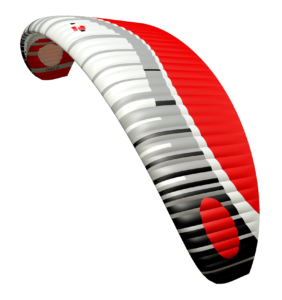Orca 5
Orca 5
Orca 5 is a universal tandem of the EN B class with excellent performance. It takes off with ease, is easy and precise in steering, complete with smooth landing. It provides the highest passive safety level, with glide ratio similar to single-seaters.
This is the first tandem with the LE3D technology applied!

Design and purpose
The wing is designed primarily for free flying with a passenger, but it will also prove its worth when powered by a paramotor – either foot-launched, or with a light paramotor trolley.
In the four-row canopy with stiffening cores (Dudek Flexi Edge technology) we have used our latest system of additional cuts on the upper surface of the leading edge – LE3D (Leading Edge 3D). The surface of the cells in these areas now consists of three longish elements instead of one.
Additional cuts minimize fabric wrinkling and more accurately reflect the designed shape of the aerodynamic profile in the crucial zones, where most lift is generated.
Additional LE3D cuts minimize fabric wrinkling and more accurately reflect the designed shape of the aerodynamic profile in crucial zones where most lift is generated. At the same time drag is minimised; all in all the glide ratio of the wing is improved.
 See movie
See movie
Orca 5 compared to previous versions:
- is the first paraglider in our offer with the implemented LE3D concept, improving its performace,
- another new feature new are the cleats on the risers, positioned for locking big ears,
- available in the new Dancing Sky color scheme.
The remaining basic parameters and solutions are the same as in the previous model. In this way, we use many years of experience gained during the testing and exploitation of previous incarnations of Orca.
The aspect ratio and other parameters have been carefully selected inorder to keep the most optimal combination of passive safety, performance, and easy yet precise steering for this class of paraglider. We focused on ensuring the best possible take-off parameters, perfect handling and efficiency of the brakes during landing.
Orca 5 inflates very well and rises up smoothly, with no tendency to lag behind. It is easy to stabilize and takes off with a touch of brakes. On landing approach, relatively small amount of braking significantly reduces speed and allows for a gentle touchdown. These features are especially important when flying with a passenger, so a lot of effort went into refining them to perfection.
Design
- The canopy was designed under our CSG (Canopy Shape Guard) system, consistIng of several subsystems, so that exceptional body coherence and its durability is ensured.
- The aerodynamic profile of the wing is based on DOA (Dudek Optimized Airfoil) technology. It was developed on the basis of our many years of experience and optimized with dedicated CFD software.
- LE3D, Flexi Edge and Shark-nose technologies are present, too.
Thanks to the careful blend of modern fabrics and design solutions, we have provided Orka 5 with high durability. All materials used come from numbered batches, and each production stage can be verified (up to identifying specific employee and inspector).
The Orca 5 comes with new, LTF certified tandem spreader bars:
The Orca 5 is manufactured in a technology that uses the capabilities of a precision laser cutter. The entire production takes place in Poland under strict control of the designer himself, guaranteeing the highest European quality of workmanship.
Specific design solutions, technologies and other functionalities are listed below in the Technologies section.
Construction solutions
TECHNOLOGIES, CONCEPTS
Risers functionality
USED SOLUTIONS
Parameters
Weight ranges

Technical details
| Name – size |
Orca 5 41 |
| Certificates | EN/LTF B, |
| Approval -ULM Identificaton | Tak |
| Number of cells | 53 |
| Surface area (flat) [m2] | 41.00 |
| Surface area (projected) [m2] | 33.99 |
| Span (flat) [m] | 14.88 |
| Span (projected) [m] | 11.41 |
| Aspect Ratio (flat) | 5.4 |
| Aspect Ratio (projected) | 3.83 |
| Speed* [km/h] | trym = 38; max = 50 (+/- 2 km/h)* |
| Weight of the wing [kg] | 7.64 |
| Total take-off weight – PG** [kg] | 120-220** |
| Total take-off weight – PPG/PPGG*** [kg] | 120 – 300 |
| Maximum symmetric control travel at maximum weight in flight [cm] | 65,00 |
| Distance betwen risers [cm] | 55,00 |
| Lines | A-8000U-050; Technora: 090/140/190/280/340/500 ; Dyneema: 350 |
| Fabric | Porcher 32 & 38 g/m2 Porcher Everlast 42 g/m2 Porcher Hard 38 g/m2 & 32 g/m2 SR-Scrim, SR Laminate 180 g/m2 |
* Speeds are given as estimated for the middle wing size and the middle of its weight range. These speeds can vary within +/- 2 km/h depending on the size, take-off weight and additional factors such as air pressure and temperature.
** The basic rule is to choose the size of the wing so that the take-off weight is in the middle of the weight range. Less weight on the wing (lower range take-off weight) can be considered for foot take-off, when flying in calmer conditions, or when we want to improve economy. More experienced pilots who want to fly dynamically, have higher speed and fly in more demanding wind conditions can consider greater wing loading (take-off weight in the upper range). This is a common option among trike users.
*** Note – the canopy significantly changes its behavior with increasing wing loading. The greater the loads, the greater skill and concentration of the pilot are required.


































